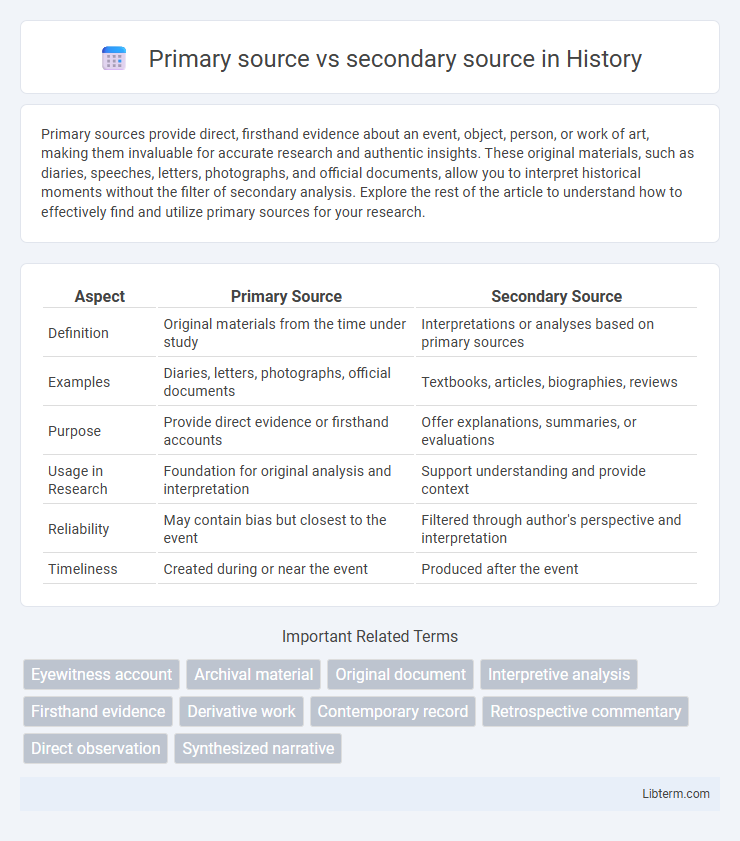Primary sources provide direct, firsthand evidence about an event, object, person, or work of art, making them invaluable for accurate research and authentic insights. These original materials, such as diaries, speeches, letters, photographs, and official documents, allow you to interpret historical moments without the filter of secondary analysis. Explore the rest of the article to understand how to effectively find and utilize primary sources for your research.
Table of Comparison
| Aspect | Primary Source | Secondary Source |
|---|---|---|
| Definition | Original materials from the time under study | Interpretations or analyses based on primary sources |
| Examples | Diaries, letters, photographs, official documents | Textbooks, articles, biographies, reviews |
| Purpose | Provide direct evidence or firsthand accounts | Offer explanations, summaries, or evaluations |
| Usage in Research | Foundation for original analysis and interpretation | Support understanding and provide context |
| Reliability | May contain bias but closest to the event | Filtered through author's perspective and interpretation |
| Timeliness | Created during or near the event | Produced after the event |
Introduction to Primary and Secondary Sources
Primary sources provide original, firsthand evidence or direct data about a topic, including documents, artifacts, recordings, or eyewitness accounts. Secondary sources analyze, interpret, or summarize primary sources, such as scholarly articles, biographies, and reviews. Understanding the distinction between these sources is crucial for accurate research and effective information validation.
Defining Primary Sources
Primary sources are original materials that provide direct evidence or firsthand accounts of events, such as diaries, photographs, speeches, and official documents. These sources are created by individuals who experienced or witnessed the event in question, offering authentic and unfiltered information. Researchers rely on primary sources to gain an accurate understanding of historical contexts and original perspectives.
Defining Secondary Sources
Secondary sources analyze, interpret, or summarize information originally presented in primary sources, typically created by scholars, critics, or researchers after the fact. Examples include review articles, textbooks, and biographies that provide context or commentary on original events or data. These sources are essential for understanding historical interpretations, academic discussions, and the evolution of ideas over time.
Key Differences Between Primary and Secondary Sources
Primary sources present original, firsthand evidence such as diaries, interviews, or official records created during the time under study. Secondary sources analyze, interpret, or summarize primary sources, including textbooks, articles, or reviews written after the fact. Key differences include the proximity to the event or subject, with primary sources offering direct access to original information and secondary sources providing context and critical evaluation.
Examples of Primary Sources
Primary sources include original documents, artifacts, recordings, or other direct evidence created during the time under study, such as diaries, birth certificates, photographs, and interview transcripts. Examples also encompass speeches, letters, official records, newspaper articles written at the event's occurrence, and raw research data. These firsthand materials provide invaluable insights for historians, researchers, and scholars seeking authentic and unfiltered information.
Examples of Secondary Sources
Secondary sources include textbooks, articles analyzing historical events, and reviews of scientific research. Examples encompass biographies, literature critiques, and documentaries interpreting original data. These sources synthesize, evaluate, or discuss information derived from primary materials such as original documents, eyewitness accounts, or experimental results.
Importance of Using Primary and Secondary Sources
Primary sources provide direct, original evidence crucial for authentic research and accurate historical understanding, while secondary sources offer interpretation and analysis that contextualize and enhance comprehension. Using both primary and secondary sources ensures a comprehensive perspective, supports critical evaluation, and strengthens the validity of academic work. Integrating these sources allows researchers to trace information back to its origin and engage with expert commentary, fostering more nuanced and credible conclusions.
How to Identify Primary vs Secondary Sources
Primary sources are original materials such as diaries, interviews, and research data created at the time of an event, while secondary sources analyze, interpret, or summarize primary sources, including textbooks and review articles. To identify primary sources, look for firsthand accounts directly linked to the subject matter without external interpretation. Secondary sources can be recognized by their reliance on primary data, providing context, commentary, or analysis rather than original evidence.
When to Use Primary or Secondary Sources
Use primary sources when original, firsthand evidence or direct data is required for research accuracy, such as historical documents, interviews, or experimental results. Secondary sources are ideal for gaining analysis, interpretation, or summaries of primary data, including textbooks, review articles, and critiques. Selecting between primary and secondary sources depends on the research objective, the need for original information, and the depth of contextual understanding.
Conclusion: Choosing the Right Source for Your Research
Selecting the right research source depends on your study's objective, with primary sources offering direct, original evidence crucial for in-depth analysis, while secondary sources provide interpretation, evaluation, and summary that can contextualize findings. For detailed accuracy and firsthand accounts, prioritize primary sources such as original documents, interviews, or artifacts. Utilize secondary sources like reviews and scholarly articles to support your arguments and gain comprehensive understanding through expert analysis.
Primary source Infographic

 libterm.com
libterm.com